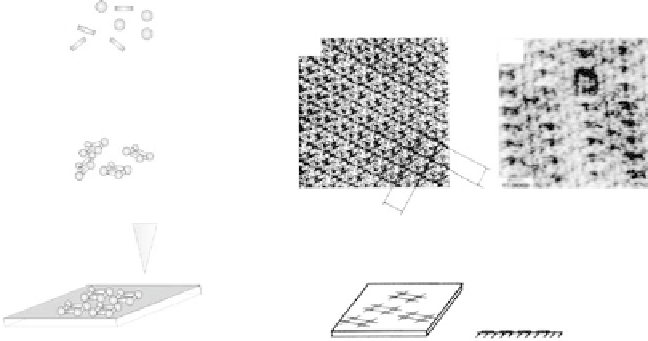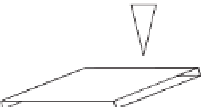Information Technology Reference
In-Depth Information
supramolecular surface structures consisting of densely packed flat-lying [2
2]
Co
4
II
metal ion arrays (MIAs) of rectangular shape are formed spontaneously
from dilute acetone solution as almost defect-free domains of up to 0.5
m
m
2
(Fig.
12.7). The domain growth proceeds outwards from single nucleation points, a
process which might be considered as two-dimensional crystallization.
Certain substitution patterns at the organic ligands provoke on-the-edge
orientation of the metal ion arrays with respect to the surface. But, most of the
observed metal ion [2
2] arrays result in flat tiles forming a ''grid-of-grids''
superarray, in which the presence of the [2
2] metal ion grids is reflected by the
2.5
2.4 nm periodicity in agreement with the molecule sizes determined by X-ray
crystallography [23].
It was shown that films of the pure [2
2] Co
4
II
metal ion arrays are poorly
conductive, but doping them with an excess of cadmium (II) ions could increase
the conductivity up to 10
2
Scm
1
[24]. In similar ways, [3
3] Mn
9
II
metal ion
arrays were deposited on both HPOG and
II
Au(111) surfaces [25]. By application
of a voltage pulse through the STM-tip on the monolayer of metal ion arrays, a
single [2
2] Co
4
II
metal ion array could be lifted, leaving a square-like hole of the
dimension of the molecule (see Fig. 12.7b). The migration rate of the hole was
measured to be 200 times slower than in a monolayer of cycloalkanes, reflecting
the degree of adsorption of the molecules to the graphite surface [23].
Further insight into the intramolecular electronic situation of isolated single
[2
2] Co
4
II
metal ion arrays at room temperature and ambient conditions could
Organic
molecules
Metal
ions
(a)
(b)
(i) Bulk-based
self-assembly
20 nm
×
20 nm
2.4 nm
STM
2.5 nm
(ii) Surface
deposition
“Grid-of-grids”
superstructure of
metal ion arrays (MIAs)
(c)
HPOG surface
Figure
12.7.
Schematic representation of the deposition of metal ion arrays
(MIAs) on surfaces: (a) STM image of the monolayer of [22] Co
I
4
metal ion
arrays on graphite. The periodicity of the grid-of-grids network is shown
with 2.52.4 nm. (b) A hole in the supramolecular monolayer is produced
by potential induced lifting of a single [22] Co
I
4
molecule with the STM tip.
(c) Schematic representation of the disposition of the MIAs at the surface (top
and side view) [23].












Search WWH ::

Custom Search